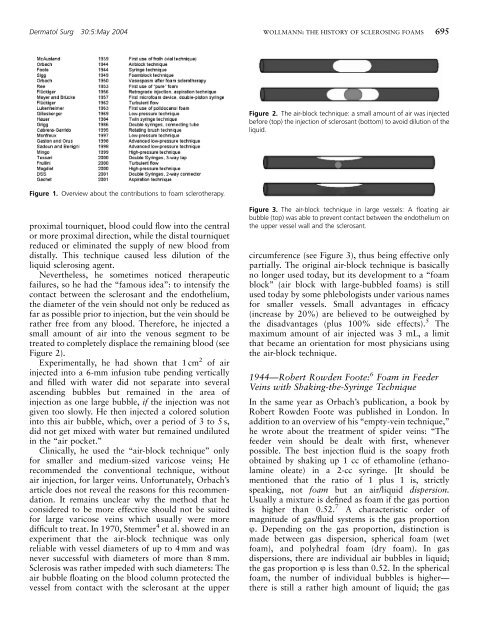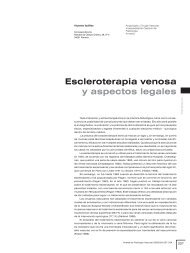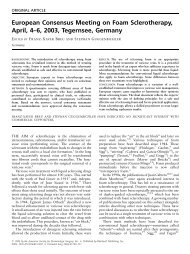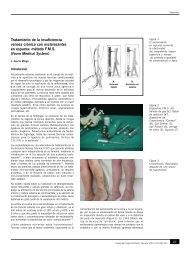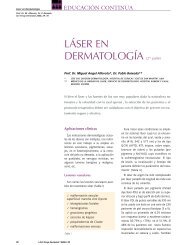The History of Sclerosing Foams
The History of Sclerosing Foams
The History of Sclerosing Foams
You also want an ePaper? Increase the reach of your titles
YUMPU automatically turns print PDFs into web optimized ePapers that Google loves.
Dermatol Surg 30:5:May 2004 WOLLMANN: THE HISTORY OF SCLEROSING FOAMS 695<br />
Figure 1. Overview about the contributions to foam sclerotherapy.<br />
proximal tourniquet, blood could flow into the central<br />
or more proximal direction, while the distal tourniquet<br />
reduced or eliminated the supply <strong>of</strong> new blood from<br />
distally. This technique caused less dilution <strong>of</strong> the<br />
liquid sclerosing agent.<br />
Nevertheless, he sometimes noticed therapeutic<br />
failures, so he had the ‘‘famous idea’’: to intensify the<br />
contact between the sclerosant and the endothelium,<br />
the diameter <strong>of</strong> the vein should not only be reduced as<br />
far as possible prior to injection, but the vein should be<br />
rather free from any blood. <strong>The</strong>refore, he injected a<br />
small amount <strong>of</strong> air into the venous segment to be<br />
treated to completely displace the remaining blood (see<br />
Figure 2).<br />
Experimentally, he had shown that 1 cm 2 <strong>of</strong> air<br />
injected into a 6-mm infusion tube pending vertically<br />
and filled with water did not separate into several<br />
ascending bubbles but remained in the area <strong>of</strong><br />
injection as one large bubble, if the injection was not<br />
given too slowly. He then injected a colored solution<br />
into this air bubble, which, over a period <strong>of</strong> 3 to 5 s,<br />
did not get mixed with water but remained undiluted<br />
in the ‘‘air pocket.’’<br />
Clinically, he used the ‘‘air-block technique’’ only<br />
for smaller and medium-sized varicose veins; He<br />
recommended the conventional technique, without<br />
air injection, for larger veins. Unfortunately, Orbach’s<br />
article does not reveal the reasons for this recommendation.<br />
It remains unclear why the method that he<br />
considered to be more effective should not be suited<br />
for large varicose veins which usually were more<br />
difficult to treat. In 1970, Stemmer 4 et al. showed in an<br />
experiment that the air-block technique was only<br />
reliable with vessel diameters <strong>of</strong> up to 4 mm and was<br />
never successful with diameters <strong>of</strong> more than 8 mm.<br />
Sclerosis was rather impeded with such diameters: <strong>The</strong><br />
air bubble floating on the blood column protected the<br />
vessel from contact with the sclerosant at the upper<br />
Figure 2. <strong>The</strong> air-block technique: a small amount <strong>of</strong> air was injected<br />
before (top) the injection <strong>of</strong> sclerosant (bottom) to avoid dilution <strong>of</strong> the<br />
liquid.<br />
Figure 3. <strong>The</strong> air-block technique in large vessels: A floating air<br />
bubble (top) was able to prevent contact between the endothelium on<br />
the upper vessel wall and the sclerosant.<br />
circumference (see Figure 3), thus being effective only<br />
partially. <strong>The</strong> original air-block technique is basically<br />
no longer used today, but its development to a ‘‘foam<br />
block’’ (air block with large-bubbled foams) is still<br />
used today by some phlebologists under various names<br />
for smaller vessels. Small advantages in efficacy<br />
(increase by 20%) are believed to be outweighed by<br />
the disadvantages (plus 100% side effects). 5 <strong>The</strong><br />
maximum amount <strong>of</strong> air injected was 3 mL, a limit<br />
that became an orientation for most physicians using<br />
the air-block technique.<br />
1944—Robert Rowden Foote: 6 Foam in Feeder<br />
Veins with Shaking-the-Syringe Technique<br />
In the same year as Orbach’s publication, a book by<br />
Robert Rowden Foote was published in London. In<br />
addition to an overview <strong>of</strong> his ‘‘empty-vein technique,’’<br />
he wrote about the treatment <strong>of</strong> spider veins: ‘‘<strong>The</strong><br />
feeder vein should be dealt with first, whenever<br />
possible. <strong>The</strong> best injection fluid is the soapy froth<br />
obtained by shaking up 1 cc <strong>of</strong> ethamoline (ethanolamine<br />
oleate) in a 2-cc syringe. [It should be<br />
mentioned that the ratio <strong>of</strong> 1 plus 1 is, strictly<br />
speaking, not foam but an air/liquid dispersion.<br />
Usually a mixture is defined as foam if the gas portion<br />
is higher than 0.52. 7 A characteristic order <strong>of</strong><br />
magnitude <strong>of</strong> gas/fluid systems is the gas proportion<br />
j. Depending on the gas proportion, distinction is<br />
made between gas dispersion, spherical foam (wet<br />
foam), and polyhedral foam (dry foam). In gas<br />
dispersions, there are individual air bubbles in liquid;<br />
the gas proportion j is less than 0.52. In the spherical<br />
foam, the number <strong>of</strong> individual bubbles is higher—<br />
there is still a rather high amount <strong>of</strong> liquid; the gas


